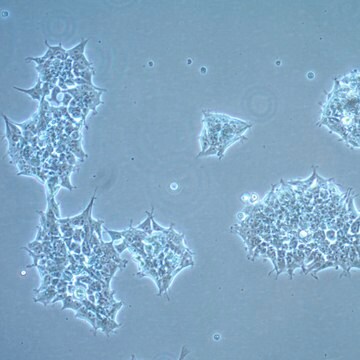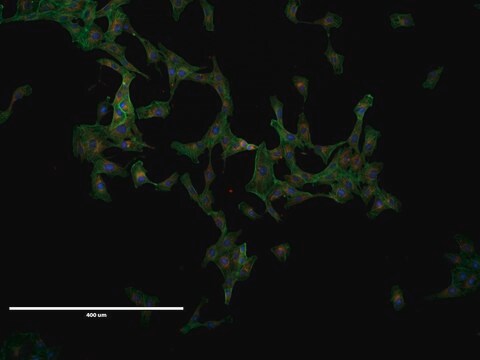293 Cell Line human
85120602, human kidney (embryonic), Epithelial
Sinônimo(s):
HEK-293 Cells, HEK293 Cells, Human Embryonic Kidney 293 Cells
About This Item
Produtos recomendados
product name
293 Cell Line human, from human kidney(embryonic), 85120602
fonte biológica
human kidney (embryonic)
modo de crescimento
Adherent
cariótipo
2n 46, hypotriploid, modal no. 64
morfologia
Epithelial
produtos
Not specified
receptores
Not specified
técnica(s)
cell culture | mammalian: suitable
Condições de expedição
dry ice
temperatura de armazenamento
−196°C
Origem de linhagem celular
Descrição de linhagem celular
Aplicação
- to study the effects of the Bt insecticidal toxins Cry1Ab and Cry1Ac alone, or with a glyphosate-based herbicide.
- for toxicological studies of ethoxylated adjuvants of glyphosate-based herbicides.
- for stable expression of either type 1 or type 2 11-βHSD (11 β-hydroxysteroid dehydrogenase) after transfection with 11-βHSD cDNA.
- as a host to transfect TLR4 cDNA (HEK-TLR4) to express TLR4 mRNA and protein and induce IL-8 (interleukin-8) promoter activity in response to NE (neutrophil elastase).
Perfil do DNA
CSF1PO: 11,12
D13S317: 12,14
D16S539: 9,13
D5S818: 8,9
D7S820: 11,12
THO1: 7,9.3
TPOX: 11
vWA: 16,19
Meio de cultura
Rotina de subcultura
Outras notas
Certificados de análise (COA)
Busque Certificados de análise (COA) digitando o Número do Lote do produto. Os números de lote e remessa podem ser encontrados no rótulo de um produto após a palavra “Lot” ou “Batch”.
Já possui este produto?
Encontre a documentação dos produtos que você adquiriu recentemente na biblioteca de documentos.
Artigos
Eukaryotic cell lines aid in complex post-translational modifications and folding of recombinant proteins. Find suitable recombinant protein production cell lines at sigmaaldrich.com
DNA, RNA, cDNA derived from ECACC mammalian cell lines allow screening for genes or expression patterns to identify lines most suitable for specific research.
Nossa equipe de cientistas tem experiência em todas as áreas de pesquisa, incluindo Life Sciences, ciência de materiais, síntese química, cromatografia, química analítica e muitas outras.
Entre em contato com a assistência técnica







